Discovering brown water in toilet can be an alarming and unpleasant experience, raising concerns about the cleanliness and safety of your home’s water supply. While it’s easy to jump to conclusions, it’s important to understand that this discoloration often has straightforward causes and solutions. From the aging pipes in your home to the quality of your water source, there are a variety of factors that can contribute to this issue. In this comprehensive guide, we will explore the eight most common causes of brown toilet water and provide practical, easy-to-implement solutions to ensure your water is clear, clean, and safe. Whether you’re dealing with mineral build-up, rusty pipes, or a more complex plumbing problem, we’ve got you covered. Let’s dive into the world of water troubleshooting, and restore the peace of mind that comes with a well-maintained home.

What Causes Brown Water in Toilet?
If you’ve noticed the water in your toilet is brown, it could be due to any of the following reasons:
1. A Lack of Toilet Cleaning
Neglecting regular toilet cleaning is a surprisingly common cause of brown toilet water. Without routine cleaning, various substances like mold, mildew, bacteria, and mineral deposits can accumulate in both the toilet bowl and tank, leading to unsightly brown stains and discoloration. This issue is particularly prevalent in toilets that are infrequently used or in homes with hard water, which can accelerate the buildup of minerals.
The Solution
- Regular Cleaning Schedule: Establishing a regular cleaning routine is crucial. This includes both the toilet bowl and the tank. Regular cleaning prevents the buildup of substances that can cause discoloration.
- Appropriate Cleaning Agents: Using the right cleaning agents makes a significant difference. For mineral deposits, products containing mild acids like white vinegar or specific toilet cleaners designed to remove hard water stains can be effective. For organic buildups like mold or mildew, bleach-based cleaners or those designed to tackle bathroom mold are appropriate.
- Toilet Brush Use: A good-quality toilet brush is essential for physically removing buildup from the bowl. Scrubbing under the rim and around the bowl can prevent the accumulation of stains and bacteria.
- Tank Cleaning: Many people neglect cleaning the toilet tank, but it’s just as important. Dropping a tank-cleaning tablet or using vinegar can help keep the tank clean and free of substances that might cause brown water.
- Addressing Hard Water: If hard water is a contributing factor, consider installing a water softening system or using water conditioners to help reduce mineral buildup.
- Professional Cleaning for Stubborn Stains: If the discoloration is severe and cannot be removed with regular cleaning, it might be worth hiring a professional cleaning service that has access to more powerful cleaning agents and tools.
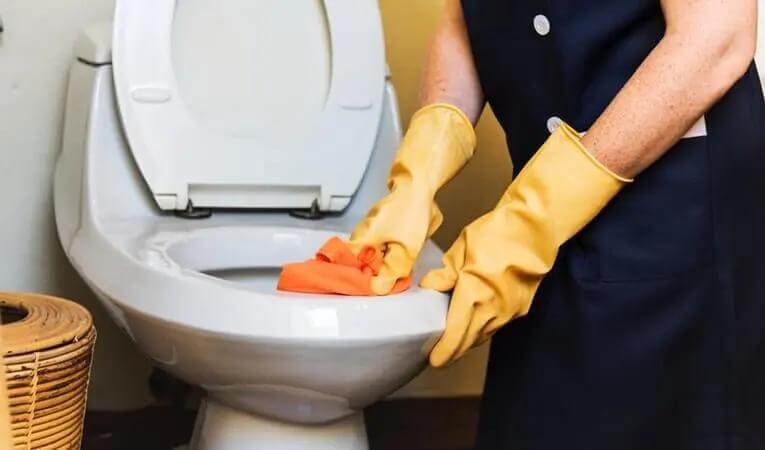
2.Rusted Toilet Components
Over time, key components in your toilet, such as the flapper and fill valve, can wear out or become defective. A deteriorated flapper may fail to form an effective seal, leading to a constant trickle of water into the toilet bowl. Additionally, if the flapper’s material starts to break down, it might contribute to rust or debris contaminating the water, causing a brown tint. In the same vein, a malfunctioning fill valve could permit impurities from your water supply to seep into the tank. However, there’s no need to fret, as addressing this issue is quite straightforward.
The Solution
To remedy this, simply replacing these old toilet parts with new ones can effectively halt further contamination and return your toilet to its optimal functioning state. This straightforward fix not only resolves the issue of brown water but also enhances the overall efficiency and reliability of your toilet.
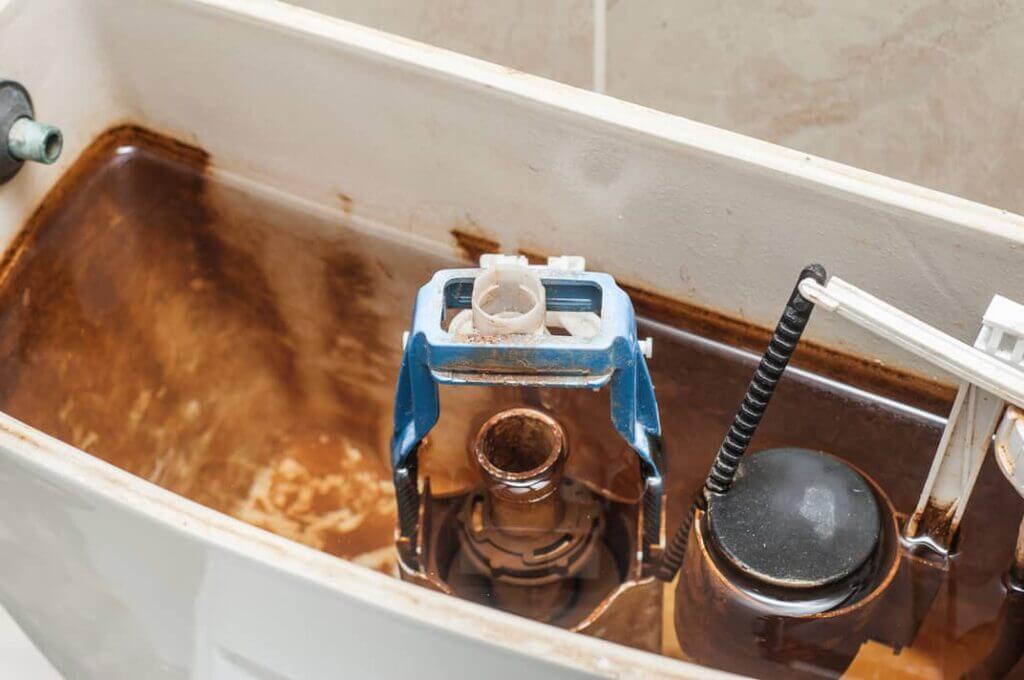
3. Rusty Pipes
Expanding on the issue of rusty pipes, which is a prevalent cause of brown toilet water, especially in older homes, it’s essential to delve deeper into both the causes and solutions of this problem.
Rusty pipes occur due to the gradual oxidation of iron and steel, the materials commonly used in older plumbing systems. Over time, exposure to water and oxygen leads to corrosion, a natural but undesirable process. This rust not only discolors the water but can also introduce harmful elements into your water supply, potentially impacting its safety and your health.
Identifying Rusty Pipes: The first step is to identify whether your brown water issue is indeed due to rusty pipes. This can often be done by inspecting exposed pipes for signs of corrosion or by noticing a pattern in water discoloration (it’s often more pronounced after the water has not been used for a while).
Solutions:
- Short-Term Fixes: In the short term, letting the water run for a few minutes might clear the discoloration. This doesn’t solve the problem but can temporarily alleviate the symptom.
- Pipe Replacement: The most effective long-term solution is to replace the corroded pipes. This can be a significant project, depending on how much of your plumbing is affected. It’s advisable to consult with a professional plumber who can assess the extent of the corrosion and recommend the best course of action.
- Preventive Measures: For those not currently experiencing issues but living in older homes, it’s wise to have your plumbing inspected. Early detection of corrosion can prevent more significant problems down the line.
- Alternative Materials: When replacing pipes, consider using materials less prone to corrosion, such as PVC, copper, or PEX. These materials have a longer lifespan and are less likely to cause water discoloration issues.
- Water Treatment Systems: Installing water treatment systems, such as water softeners or filtration systems, can also help reduce the rate of pipe corrosion by treating the water before it flows through your pipes.
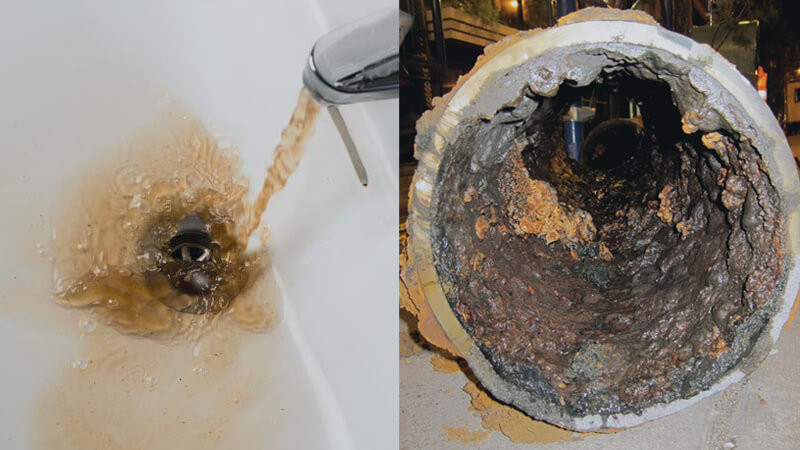
4.Excess Hard Water Minerals
When your water supply is rich in minerals like iron and manganese, it can lead to the brown discoloration of toilet water. These minerals are naturally occurring in many water sources, particularly in well water or areas with high mineral content in the soil. When water high in iron or manganese sits in your toilet tank or bowl, it can leave behind a brownish residue, particularly if the water is also hard.
The Solution
- Specialized Pre-Toilet Filtration Systems: Using a specialized filtration system designed to be installed before the water reaches your toilet can be highly effective. These filters are specifically tailored to remove excess minerals such as iron and manganese from the water. By filtering these minerals out before they enter your toilet, you can prevent the brown discoloration from occurring.
- Regular Cleaning: To address any buildup of mineral deposits, regular cleaning of both the toilet tank and bowl is essential. White vinegar is an effective cleaning agent for this purpose, as its acetic acid content can dissolve mineral deposits without harming the toilet surfaces.
- Water Testing: It’s beneficial to test your water to understand its exact mineral composition. Knowing the levels of iron, manganese, and other minerals in your water can help you select the most suitable filtration system to address your specific needs.
- Maintenance of Filtration Systems: Regular maintenance of your pre-toilet filtration system is crucial to ensure its effectiveness over time. This includes monitoring the system for any signs of clogging or reduced efficiency and replacing filters as recommended by the manufacturer.
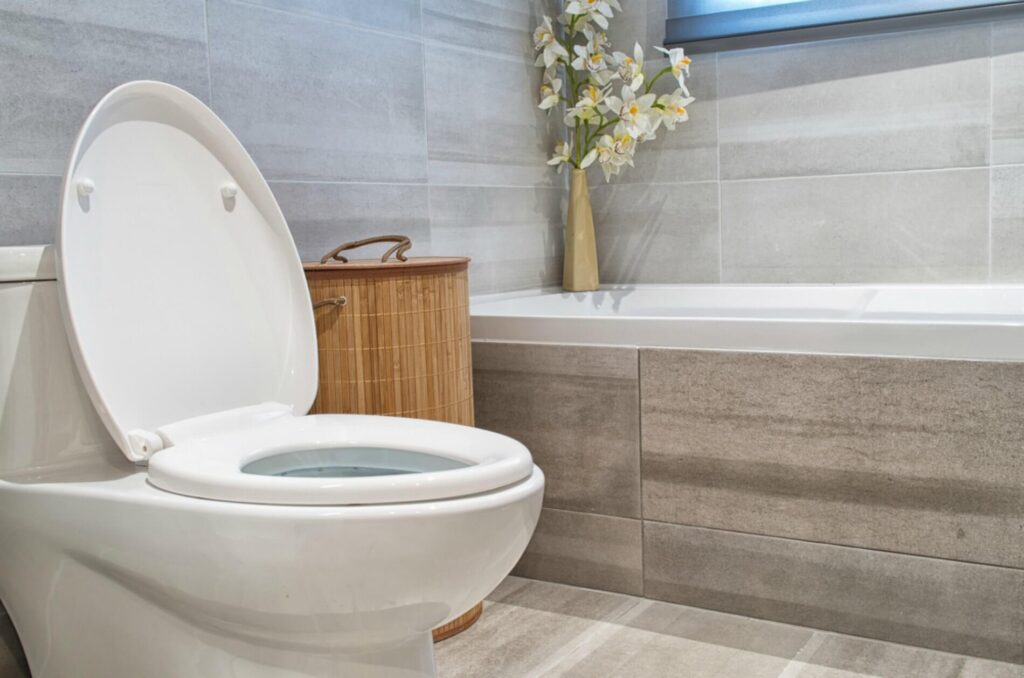
5. Clogged Pipes
Clogged pipes are another common cause of brown toilet water. Over time, various substances such as hair, grease, sediment, and other debris can accumulate in your plumbing system, leading to blockages. These blockages can restrict water flow and cause sediment to stir up, resulting in brownish water appearing in your toilet. This issue is more prevalent in homes with older plumbing systems where the pipes may be narrower and more prone to clogging.
The Solution
- Regular Cleaning and Maintenance: Preventing clogs starts with regular maintenance of your pipes. Avoid flushing anything other than toilet paper down the toilet. Also, be mindful of what goes down your sink and shower drains.
- Use of a Plumbing Snake: For minor clogs, a plumbing snake can be a handy tool. It’s a flexible rod that can be inserted into the pipes to dislodge any blockages. This can often be done without the need for professional help.
- Enzyme-based Cleaners: Regular use of enzyme-based cleaners can help break down organic materials in your pipes, preventing the buildup that leads to clogs. These cleaners are a more environmentally friendly option compared to harsh chemical cleaners.
- Professional Plumbing Services: For more severe clogs or if you are uncomfortable tackling the issue yourself, it’s wise to call in professional plumbers. They have the expertise and equipment to diagnose and effectively clear out clogged pipes, ensuring your plumbing system functions smoothly.
- Pipe Inspection and Repair: In cases of recurrent clogs or older plumbing systems, a comprehensive inspection may be necessary. Plumbers can use cameras to inspect pipes for damage or severe blockages. Sometimes, repairing or replacing sections of piping might be required to resolve the issue permanently.
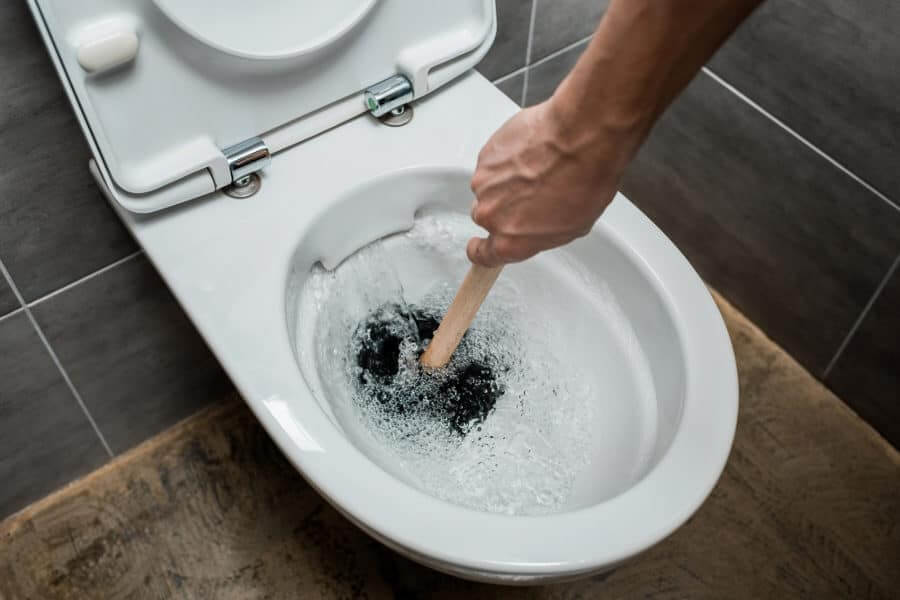
6.Municipal Work or Water Source Issues
Occasionally, brown toilet water can be a result of external factors, such as municipal work on the water supply system or changes in the water source. Maintenance activities like pipe repairs, reservoir cleaning, or changes in water treatment processes can stir up sediments or introduce iron and manganese from old pipes, leading to temporary brown discoloration in your home’s water supply. Similarly, if the source of your water changes (for instance, from a reservoir to a river), the different mineral content can affect water color.
The Solution
- Staying Informed: Keep abreast of local water utility announcements. Municipalities usually inform residents about maintenance work or changes in the water supply. This information can help you anticipate water quality issues.
- Flushing Your System: After municipal work, running the cold water taps in your home for a few minutes can help flush out discolored water. This is particularly effective if the discoloration is due to stirred-up sediments.
- Using Water Filters: Installing whole-house water filters can significantly reduce the impact of these changes. These filters are designed to remove sediments, rust, and other impurities, ensuring consistent water quality regardless of external changes.
- Contacting Water Authorities: If you notice a change in your water quality, it’s advisable to contact your local water authority. They can provide information on whether the change is temporary due to maintenance work or if there is a more significant issue at hand.
- Water Testing Kits: Using home water testing kits can help you understand the specific contaminants in your water. This is particularly useful if you suspect that the change in water quality is not just due to municipal work but a more permanent alteration in the water source.
- Backup Water Supply: In cases of prolonged water quality issues, having a backup water supply, like bottled water for drinking and cooking, can be a practical temporary measure.
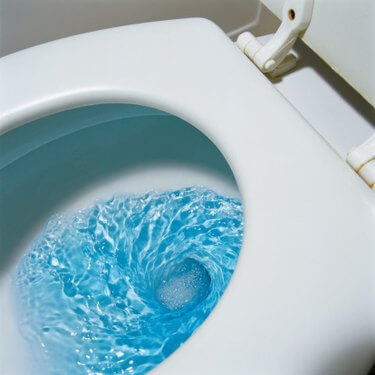
7. Sewer Line Issues
Sewer line issues are a more severe cause of brown toilet water and can indicate significant plumbing problems. If there’s a blockage or damage in the sewer line, it can lead to backflow problems, where wastewater mixes with the clean water in your toilet. This not only causes brown water but also poses serious health hazards due to the potential presence of bacteria and other pathogens in the wastewater.
The Solution
- Early Detection: Pay attention to signs like slow draining, gurgling sounds, or unpleasant odors from drains. These can indicate sewer line issues before they become severe.
- Professional Inspection and Repair: At the first sign of a sewer line problem, it’s crucial to call in professional plumbers. They can conduct a thorough inspection using specialized equipment like sewer line cameras to locate the exact issue.
- Regular Maintenance: Regular sewer line maintenance, such as annual inspections and cleaning, can prevent many issues. Plumbers can remove buildup and spot potential problems early on.
- Avoiding Drain Blockages: Be mindful of what goes down your toilets and sinks. Avoid flushing anything other than toilet paper and avoid pouring grease or other clogging substances down your drains.
- Tree Root Intrusion: For homes with large trees, root intrusion into sewer lines can be a common problem. Tree root barriers or occasional root treatments can be effective preventative measures.
- Sewer Line Replacement or Relining: In cases of severe damage or old, deteriorated pipes, replacing or relining the sewer line might be necessary. While this can be a major project, it’s often the only long-term solution to prevent recurrent issues.
- Backup Prevention Devices: Installing devices like backwater valves can prevent sewage from backing up into your home if there’s a blockage downstream.
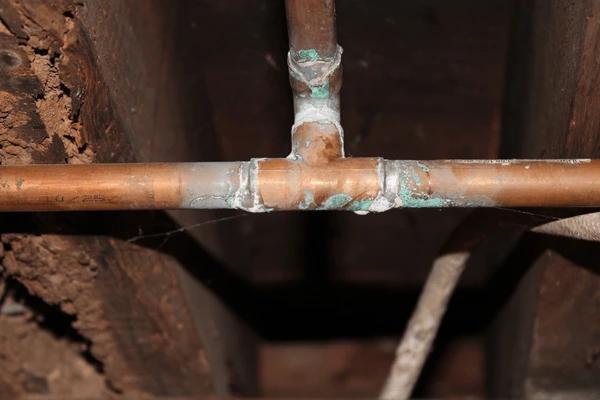
8.Corroded Well
For homes that rely on well water, corrosion in well components can be a significant cause of brown water in toilet. This issue typically arises when parts of the well system, such as pipes, casings, or pumps, start to deteriorate. The corrosion can release iron and other minerals into the water, leading to discoloration. Additionally, a well’s age, the acidity of the water, and the presence of certain bacteria can accelerate the corrosion process.
The Solution
- Regular Well Inspection and Maintenance: Conducting regular inspections and maintenance of your well can help identify signs of corrosion early. This includes checking the physical condition of all accessible components and testing the water quality for signs of increased metal content.Better yet, consider having the well tested to ensure it complies with the regulations set by the Centers for Disease Control and Prevention (CDC).
- Water Testing: Regular testing of well water is crucial to monitor its quality and the presence of corrosive elements. This helps in determining the most effective treatment solutions.
- Corrosion-Resistant Materials: When repairing or upgrading well components, opt for corrosion-resistant materials. These can include certain types of plastics or treated metals, which are less prone to corrosion.
- pH Balancing Treatments: If the water’s acidity is contributing to corrosion, pH balancing treatments can be applied. Adjusting the pH level of the water can slow down the corrosion process.
- Installing Water Filters: Specialized filters that remove iron and other minerals can be installed. These filters treat the water as it enters your home, preventing the brown discoloration and protecting your plumbing.
- Shock Chlorination: If bacterial growth in the well is contributing to corrosion, a process known as shock chlorination can be performed. This involves adding a high concentration of chlorine to the well and then flushing it out after a certain period, helping to kill bacteria.
- Professional Well Services: For complex issues, consulting with a professional well service is advisable. They can provide expert assessment and solutions for well corrosion problems.
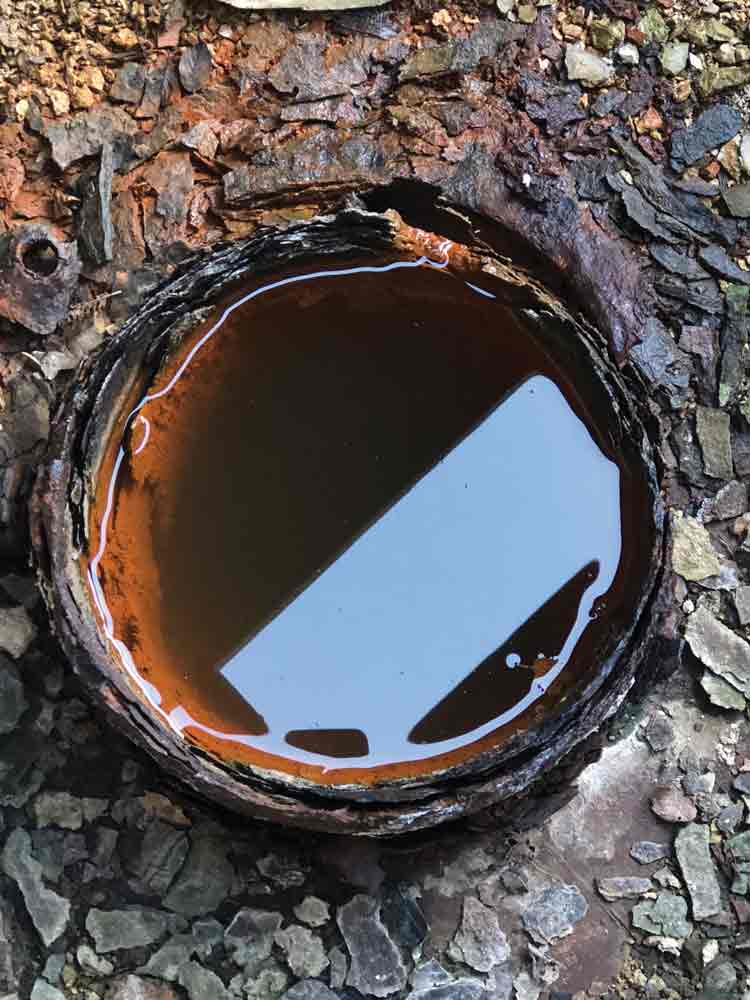
Conclusion: The Efficacy of Pre-filter Systems
In summarizing our exploration into the common causes of brown water in toilet, it becomes evident that one of the most effective solutions is the implementation of a pre-toilet filtration system. This approach stands out for its direct and efficient method in tackling the issue at its source.
Pre-toilet filters are designed to intercept and remove impurities before they ever reach your toilet. Whether the problem stems from rusty pipes, excess minerals in your water supply, or sediment from municipal work, these filters are adept at providing a first line of defense. They effectively filter out iron, manganese, and other particulate matter that cause brown discoloration, ensuring that the water entering your toilet is clean and clear.
The advantages of installing a pre-toilet filtration system are manifold. Firstly, they address the aesthetic concern of brown water, restoring the clarity and cleanliness that is vital for hygiene. Secondly, by removing corrosive elements before they can affect your plumbing, these filters can extend the life of your toilet’s components, reducing the need for frequent repairs and replacements. Additionally, they offer peace of mind, as they contribute to the overall health and safety of your home’s water supply.

In essence, while there are multiple strategies to address the issue of brown toilet water, a pre-toilet filtration system offers a comprehensive and proactive solution. It not only resolves the current problem but also serves as a preventative measure against future water quality issues. Investing in such a system is a wise decision for any homeowner seeking to maintain a high standard of water cleanliness and plumbing efficiency.
Thus, as we conclude this guide, it’s clear that integrating a pre-toilet filtration system is a superior approach to ensuring your toilet water remains free from discoloration, embodying a blend of efficacy, convenience, and long-term reliability.
